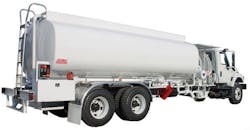BETA’s Re-Launch Begins with 5K Refueler
Although BETA Fueling Systems had manufactured refuelers ranging from 3,000 to 10,000 gallons in size for several years for both the U.S. and international markets, the company saw an opportunity to redesign the vehicles and re-launch its refueler platform.
As a result, BETA debuted the 5K Aircraft Refueler earlier this year.
“The 5K is a versatile piece of equipment that doesn’t need a hydrant system to fuel aircraft,” BETA’s VP of sales and marketing, Michael D'Angelo explains. “This can be used in commercial or FBO type airports for both domestic and international airport locations.”
The design of the former refuelers had the module behind the cab, rather than a skirt design, which company officials say was ideal for shipping out of country, but had some drawbacks compared to a modular skirt-style design.
“The skirt-style module design allows the tank to be shorter in height and length and the fueling module is easier to access for maintenance, which is why we are re-launching our refueler platforms,” D’Angelo says.
Representatives at BETA note they did not set out to reinvent their offerings. Rather, they focused on making specific key improvements.
“The design was inspired by BETA’s core values of reliability, support and delivery,” BETA’s director of engineering, Kris Soderstrom says. “We wanted to make the design simple, reliable and easy to work on. Before the design began, we had customer site visits and discussions with maintenance personnel and operators to see what has worked best and what they have liked on past designs. You can see many of these inputs on our new 5K Refueler.”
The fuel system is designed for maximum protection from years of use by utilizing a narrow module. That allows the module to be protected by the chassis and flexible joints are used to protect the pipework from chassis flex, preventing leaks.
“Our systems also come standard with our CCM (Central Command Module), which is an information touchscreen in the cab that provides quick diagnostics, fueling instructions and training for new operators,” D’Angelo adds.
“Moreover, we utilize an aluminum filter water separator, an aluminum module frame and stainless steel piping,” Soderstrom continues. “These components will never corrode and will extend the life of the vehicle as well as being lighter weight, which puts less wear and stress on the chassis.”
BETA’s all-aluminum filter vessel does not require epoxy, so no future maintenance is needed. It also features an underwing hose reel with electric rewind and a single foot valve for simplicity and ease of maintenance. Additional options include a third overawing hose reel, additive system, extended hose lengths, an Aljac recovery tank and back-up cameras.
“We meet or exceed A4A requirements and have an option to easily satisfy and meet the more stringent JIG standards,” Soderstrom notes. “Included are ergonomic nozzle stowage systems, back-up alarm, two fire extinguishers, A4A labels, DOT 406 certified tank and bumper, an optional tank handrail system, generous LED panel and work lighting and emergency fuel stops on both sides of the vehicle.
“Additionally, we only use scissor-lifts, which are more stable than mast-style lifts when elevated, so it’s safer with high wind conditions and heavier loads in the lifts.”
BETA also has plans to launch 3K and 7K versions with lift options based on the same platform as the 5K Refueler. Further refueler products, both larger and smaller, will be developed in time once the company fully validates the design.
To determine the appropriate size refueler for an operation, BETA officials say users must consider the type of aircraft being refueled and how far the tank farm is from aircraft. What’s more, operators and maintenance personnel should feel comfortable using and maintaining fueling equipment.
However, BETA representatives say they have spent a great deal of time designing the equipment and choosing components that require minimum maintenance.
“The chassis is the main component that requires regular maintenance as with any other piece of equipment containing an engine and drive shaft system.”
Weather and geographical location is also a significant factor.
“In cold weather locations, for example, we offer a soffit and hose cover to cover the hoses, meter and electronics so snow and ice doesn’t build up on the functional parts,” D’Angelo points out. “An airport with high traffic volume may decide to go with a smaller refueler with a tighter turning radius because of the lack of real estate to work with around the aircraft area.”
About the Author
Josh Smith
Editor
Josh Smith served as editor of Ground Support Worldwide as editor from 2016 through 2024. He oversaw production of the print magazine, created GSW's newsletters on a daily basis, and updated the latest news on AviationPros.com.

